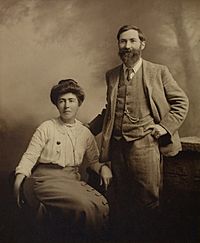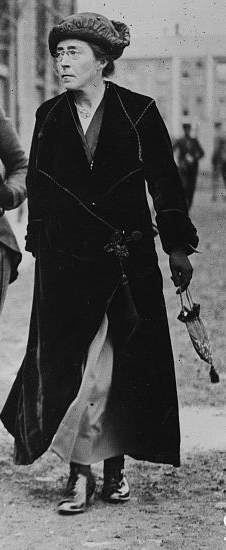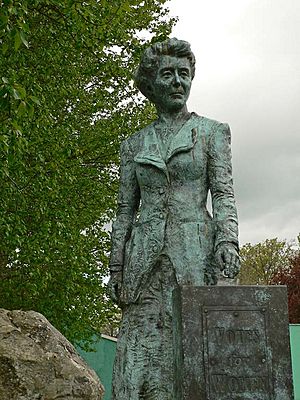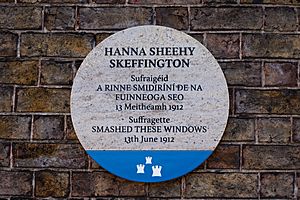Hanna Sheehy-Skeffington facts for kids
Quick facts for kids
Hanna Sheehy Skeffington
|
|
|---|---|
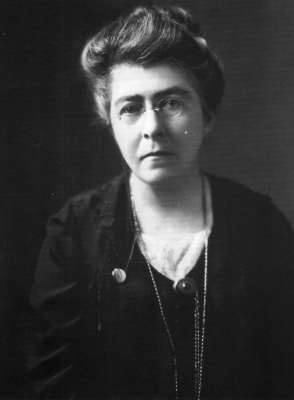 |
|
| Born |
Johanna Mary Sheehy
24 May 1877 Kanturk, County Cork, Ireland
|
| Died | 20 April 1946 (aged 68) Dublin, Ireland
|
| Nationality | Irish |
| Occupation | Teacher, Activist, Politician, Author, Editor |
| Known for | Suffragette and other activism |
| Spouse(s) | Francis Sheehy-Skeffington |
Hanna Sheehy Skeffington (born Johanna Mary Sheehy; 1877–1946) was a brave Irish woman. She fought for women's right to vote. She also worked for Irish independence. With her husband, Francis Sheehy Skeffington, she helped start the Irish Women's Franchise League in 1908. This group worked to get women the right to vote. She also helped create the Irish Women Workers' Union. Her son, Owen Sheehy-Skeffington, later became an important politician in Ireland.
Contents
Hanna's Early Life and Family
Hanna Sheehy was born in Kanturk, County Cork, Ireland, in 1877. Her parents were Elizabeth McCoy and David Sheehy. Her father was a politician and a Member of Parliament (MP). He represented South Galway.
Hanna spent her first years in a millhouse. Her family moved to Loughmore, Tipperary, when she was three. She had six siblings. One of her uncles, Father Eugene Sheehy, was known as the Land League Priest. He was even jailed for his actions.
In 1887, Hanna's family moved to Dublin. They lived next door to the Lord Mayor of Dublin. When Hanna was 18, she went to Germany for a short time. She went there for medical treatment.
After college, she worked in Paris for a while. She returned to Ireland in 1902. Hanna's brother Richard was good friends with the famous writer James Joyce. Joyce even wrote about the Sheehy family in his book Ulysses.
When Hanna was a teenager, her family often had open houses. Young people, including James Joyce, would visit. They enjoyed singing and playing games together.
Hanna's Education Journey
Hanna went to the Dominican Convent on Eccles Street. She was a very good student there. She then studied French and German at St Mary's University College. This was a special college for women.
She earned her Bachelor of Arts degree in 1899. In 1902, she received her Master of Arts Degree with top honors. After college, she became a teacher at Eccles Street. She also worked as an examiner for school tests.
Hanna's Personal Life
Hanna met Francis Skeffington through their friend James Joyce. Francis was from County Down. Hanna and Francis often met at Bewley's Cafe. They talked about politics, art, and religion.
They got married on June 3, 1903, in Dublin. They wore their college graduation gowns instead of traditional wedding clothes. Both Hanna and Francis decided to use the last name Sheehy Skeffington. This showed their equal respect for each other.
This decision made Francis's father upset. He saw it as a betrayal of their family name. The couple moved to Rathgar, Dublin, after their wedding. Hanna and Francis had one son named Owen.
Hanna's sister Mary married the writer Thomas Kettle. Another sister, Kathleen, married Frank Cruise O'Brien. She was the mother of Conor Cruise O'Brien.
Hanna's Political Activism
Hanna grew up in a family that strongly supported an independent Ireland. She was inspired by James Connolly. During the 1913 Dublin Lock-out, she helped striking workers. She provided food for their families.
She fought hard for women's right to vote in Ireland. In 1908, she co-founded the IWFL. She also started a newspaper called "The Irish Citizen" with her husband. This newspaper supported women's rights.
Hanna also supported Irish independence. She helped during the 1916 Easter Rising. She delivered messages and food to the General Post Office (GPO).
She was against the First World War. In 1915, the British government stopped her from attending a peace meeting. In June 1915, her husband was jailed for speaking against the war. He was later killed during the 1916 Easter Rising. Hanna refused to accept money for his death.
Hanna supported Sinn Féin, an Irish political party. In 1916, she traveled to the United States. She gave many speeches about Ireland's fight for independence. She attended 250 meetings to raise awareness.
When she returned in 1917, she became a leader in Sinn Féin. She also wrote a book called British Militarism as I Have Known It. This book was banned in the United Kingdom. She was later jailed in Holloway prison.
Hanna supported the anti-Treaty side during the Irish Civil War. In 1920, she became a councillor for Dublin Corporation. In 1926, she joined Fianna Fáil, another political party. She was an assistant editor for An Phoblacht, an Irish Republican Army journal, in the 1930s.
In 1933, she was arrested in Newry for entering Northern Ireland. She had been banned from there. At her trial, she said she did not recognize the division of Ireland. She was sentenced to one month in prison.
In 1943, at age 66, Hanna ran for the Dáil (Irish Parliament). She ran as an independent candidate. She did not win the election.
Hanna's Fight for Women's Rights
Hanna Sheehy Skeffington was a founding member of the Irish Women Workers' Union. She wrote against British rule in Ireland. She was a close friend of Cissie Cahalan, a trade unionist.
The Irish Women's Franchise League (IWFL) started in November 1908. Hanna, her husband Francis, Margaret Cousins, and James Cousins were founding members. The IWFL grew to be one of the biggest suffrage groups. It fought for Irish independence and women's voting rights.
The IWFL wanted women's votes included in the Home Rule Bill. They held weekly meetings in Dublin's Phoenix Park. They also organized rallies across the country. By 1912, the IWFL had about 1000 members.
On June 13, 1912, Hanna and seven other women were arrested. They had broken windows at Dublin Castle during a protest. They were jailed in Mountjoy prison for a month. They were treated as political prisoners.
In November 1913, Hanna tried to give leaflets to political leaders. She was arrested again for her protest actions. She was sent to Mountjoy Prison. She went on a hunger strike for five days until she was released.
In 1913, Hanna lost her teaching job. This happened because of her strong involvement in women's rights protests. In August 1918, she was arrested again and went on a hunger strike in jail.
Hanna helped create the Women's Prisoners' Defence League. This group campaigned and raised money for Irish republican prisoners. She worked with Maud Gonne and Charlotte Despard.
Hanna attended the Women's International League for Peace and Freedom conference in 1926. She also spoke out against a bill in 1935. This bill would have limited job opportunities for women.
In 1937, she helped start the Women's Social and Progressive League. She was unhappy with parts of the new Irish Constitution. She felt it did not do enough for women.
The Irish Citizen Newspaper
The Irish Citizen was a feminist newspaper. Hanna Sheehy Skeffington and Margaret Cousins started it. It was first published on May 25, 1912. It was an eight-page weekly newspaper.
By June 1912, it sold 3,000 copies and reached many readers. Its motto was: "For Men and Women Equally The Rights of Citizenship; For Men and Women Equally The Duties of Citizenship."
Hanna's husband, Francis Sheehy-Skeffington, was one of the first editors. Hanna said the newspaper aimed to support women's right to vote. It also stood for the rights of workers, especially women workers.
The newspaper covered topics like Home Rule and Irish independence. It gave women and the suffrage movement a voice. Hanna became the editor after her husband's death in 1916. She continued this role until the newspaper stopped publishing in 1920.
Hanna's Lecture Tours in America
After her husband's death, Hanna was not happy with the court's decision. She decided to share her story in America. She gave over 250 speeches for 19 months. She spoke about "British Militarism."
Hanna's first speech was on January 6, 1917, in Carnegie Hall, New York City. She then toured many cities in the East and Midwest. Newspapers described her as "a wonderful woman" with "remarkable self-control."
She spoke to large crowds in places like Boston and Chicago. Journalists, judges, and other important people attended her talks. She also spoke at Columbia and Harvard Universities.
Hanna traveled to the West Coast in 1917. She visited California, Los Angeles, and San Francisco. She wanted to visit even more cities.
In January 1918, Hanna received a petition from Irish women. It asked President Wilson to include Ireland in the fight for freedom. Hanna spoke at Madison Square Garden in May. She then returned to New York City with her son, Owen Sheehy-Skeffington.
She went on a second tour in 1922. She traveled with Kathleen Boland and Linda Kearns. They raised money for Irish prisoners and their families. They spoke about the conditions in Ireland during the War of Independence. Their tour ended in May 1923, raising $123,000.
Later Life and Legacy
Hanna Sheehy Skeffington died in 1946 at age 68 in Dublin. She is buried with her husband in Glasnevin Cemetery.
There is a bronze statue of Hanna in Kanturk, County Cork, Ireland.
In the 1990s, students at University College Dublin wanted to honor Hanna. They asked to rename their Gender Studies building after her. They wanted to recognize her work for women's rights. Their campaign was successful. The building is now called the Hanna Sheehy Skeffington Building.
Her name and picture are on the plinth of the statue of Millicent Fawcett in London. This statue was unveiled in 2018.
A blue plaque in Dublin Castle remembers Hanna's protest. It marks where she broke windows for women's right to vote. Her important papers are kept in the National Library of Ireland.
Images for kids


